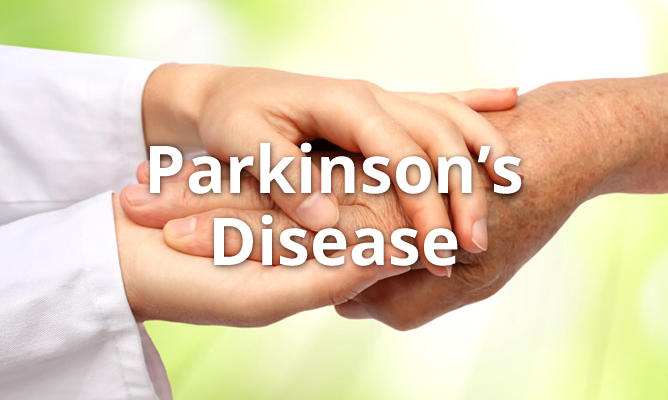 According to the National Parkinson Foundation (NPF), approximately 60,000 new cases of PD are diagnosed each year, joining the 1.5 million Americans who have the disease.
According to the National Parkinson Foundation (NPF), approximately 60,000 new cases of PD are diagnosed each year, joining the 1.5 million Americans who have the disease.
PARKINSON’S DISEASE SYMPTOMS
Parkinson’s disease in the elderly is not easily diagnosed, as neither x-rays nor blood tests reveal the condition, though blood tests and magnetic resonance imaging (MRI) can be used to eliminate other conditions.
Like Alzheimer’s disease, the most common neurodegenerative condition in America, symptoms of Parkinson’s patients progress and worsen over time.
Because there is so much variability among patients in how the disease progresses, doctors are not able to accurately predict how quickly symptoms will worsen, or even which specific symptoms will develop for each patient.
Persistent body tremor is the most common symptom of Parkinson’s disease in the elderly.
PARKINSON’S DIAGNOSIS
To further complicate diagnosis, onset of PD symptoms does not definitively mean the patient has the disease. Parkinsonism, the term for displaying symptoms without actually having Parkinson’s disease, was found in 35% of those patients monitored in a recent study.
In order to properly diagnose Parkinson’s disease in the elderly, a neurologist or other qualified physician must make the appropriate neurological examination and evaluate the patient’s complete medical history.
PARKINSON’S DISEASE TREATMENT
While Parkinson’s disease in the elderly remains an irreversible and progressive disease, several medications are now used to treat and control its symptoms.
Carbidopa aids in the absorption of levodopa in the body and also helps to reduce some of its side effects, which may include hallucinations, drops in blood pressure, nausea, and involuntary muscle movements (called dyskinesia).
The resulting increase in dopamine levels helps to relieve the slowness, rigidity, and tremor symptoms caused by the destruction of dopamine-producing brain cells in PD. Although dopamine agonists tend to have fewer motor side effects than levodopa, they appear more likely to cause hallucinations as well as compulsive behaviors. And, because the various dopamine agonists all differ somewhat, doctors may need to try different ones before finding one that works most effectively with the fewest side effects.
In addition to the dopamine-producing and -mimicking drugs described above, doctors may prescribe other drugs to be used in conjunction or as alternatives in case they become less effective.Selegilineworks by inhibiting the breakdown of dopamine and is often used in conjunction with levodopa/carbidopa therapy.Amantadineis an antiviral that has been found to alleviate some of the symptoms of PD.
Levodopa and the other medications described above have been very successful at controlling the symptoms of PD, but over time these drugs become less effective as the disease progresses in a patient. This can take many years, as patients experience more frequent periods where there is an increase in symptoms as the effects of the medications wear off.
Several surgical techniques have been developed for PD, although it’s important to emphasize that none of them offers a true cure, and that there are risks:
Thalamotomyandpallidotomyare brain lesioning procedures that destroy different regions of brain tissue involved in PD.
Deep brain stimulation(DBS) is considered an alternative treatment to lesioning surgery. A metal electrode is placed in the targeted area of the brain and a pulse is generated to alter the abnormal function of that region. DBS may be conducted in both sides of the brain if symptoms warrant it and only if the patient is in good health.
Patients with PD often feel a great deal of anxiety, knowing that the progression of the disease is irreversible. This fear often causes patients to turn inward and avoid others with the disease, shielding themselves from what they perceive to be their future state. This obstinacy can make it difficult for family and supporters to persuade the patient to join Parkinson’s support groups and other activities with peers.
PD is a twenty-four hour condition, though days can vary significantly. The same medicinal combination that worked fine yesterday can appear ineffective today. Anger and depression, the result of physical frustration, the loss of independence, and hypersensitivity, surfaces for everybody.
The NPF suggests that a favorite physical hobby such as playing a musical instrument be replaced with another, more cognitive activity, like attending concerts. In addition, many patients report that they have continued to work successfully in their jobs, pursue their careers, and maintain their social and cultural lives.
The first step a recently diagnosed patient should take, is to talk with someone who really understands the disease. Finding a care team that really listens and provides good feedback will really help the patient maintain a good quality of life.
Article Source: http://www.aplaceformom.com/senior-care-resources/articles/parkinsons-disease-in-the-elderly

